

Foreword
Ms Seow Ai Wee, Deputy Director (Art) from STAR
Fostering a teacher-led culture requires the fraternity to trust each other as collaborators, and to take courage in leading as facilitators. This issue highlights how our Art teachers contribute to the professional growth of colleagues, and collaborate with each other to raise the quality of teaching and learning in art. It also includes insights and reflections from teacher-facilitators who have conducted STAR Champions Zonal Workshops and AST Teacher-Led Workshops focused on inquirybased learning, experimentation and play. The joyful learning and thoughtful sharing among colleagues and friends is evident in the words and images throughout the pages.
As this issue of STAR-Post came together, I was encouraged by how the fraternity embraced learning, and grateful to colleagues who have been forthcoming in sharing successes and challenges. I was also heartened to learn about the many professional development Happenings within schools and in the community led by individuals and small groups charged with the mission to deepen learning in art, and a vision to create a vibrant art culture. The Art teachers took on the roles of facilitators and collaborators as they led interdisciplinary collaborations, cluster-based exchange, and community-focused projects.
I hope you will enjoy the read, and be inspired to create a culture of intersectional thinking and transformational learning.

To Get There, We Go Together
Written by Mr Lim Kok Boon, Master Teacher (Art) from STAR
The topic of ‘teacher-led professional development’ is a term that creeps up from time to time when we talk about a culture of professional excellence, or innovations that will bring education forward. I want to take this opportunity to articulate how and why teachers gain from participating in and leading professional development. In this expository essay, I will make some connections to adult learning theories and research-based claims about effective professional development. It is not a literature review on the topic. I hope more teachers can be convinced that sharing our teaching ideas is not as frightening as we might think it is, but instead, start to see it as an endeavour that is liberating and rewarding.
Teacher-led professional development might imply different degrees of teacher involvement from the individual’s perspective. We might
describe a teacher’s involvement using three levels, with the next level including characteristics of the previous level. At the most basic level, teacher-led professional development can refer to teachers taking the initiative and ownership for their professional learning and deciding what courses or workshops they would like to attend. At the intermediate level, it often implies coming together to share learning resources and learning from one another. Here, teachers may also work in teams to solve a teaching issue. They might do this through a variety of collaborative inquiry protocols, such as a tuning protocol (Blythe & Allen, 2016), where they share their reflection on their work and their students’ work and invite others to share their views, praises, questions and suggestions. At the advanced level, teacherled professional development implies taking one form of leadership where one or more persons “step-up” to take charge, taking the
initiative of action to rally and inspire others. Even if that form of leadership is a collective one where every decision is made collectively, the leaders facilitate and mediate.
According to an article by Harrison and Killion (2007), teachers exhibit leadership in many ways. Leadership can be defined by leadership appointments with clear responsibilities as well as informal leadership roles. I have used part of Harrison and Killion’s list (numbers 1 to 4) and added three from Malcolm Gladwell (2000, numbers 5 to 7), naming seven informal teacher leadership roles that we might find applicable in local contexts.
1Learning resource providers – share their own teaching materials.
2Instructional strategists – help colleagues to contextualise innovative pedagogy for the classroom and help implement effective instructional strategies and teaching actions.
3Curriculum and syllabus experts – help colleagues understand the syllabus by explaining how the various components come together.
4Buddies and mentors – help colleagues ease into a new school or advise new teachers on school culture, curriculum and administrative matters.
5Mavens – model continual improvement and lifelong learning. Mavens are information specialists that help colleagues connect with new information.
6Connectors – describe people who know a large number of people and frequently help make introductions.
7Salespersons – describe people who possess good charisma and strong negotiation skills.
From these varied roles, teachers may draw on their strengths, personality and interests to
find ways to lead, and in doing so, contribute to the professional learning of others. Playing leadership roles can allow teachers to exercise existing and foster new leadership skills.
We might find opportunities for teachers to demonstrate their leadership through different platforms and modes. The ones I have come across are peer-to-peer informal professional conversations, peer-lesson observations, mentoring programmes, department or subject-unit meetings or staff contact time, time-tabled time, professional learning teams, action research teams, professional learning circles, networked learning communities, clusters’ instructional programme support groups (IPSG) or teacher-led workshops. From my experience, the more enduring and endearing professional development experiences are those that take time to build relationships between people, rather than mechanical platforms for professional learning. According to Vygotsky (1978), learning is as much social as it is intellectual. Learning is also as much affective as it is cognitive (Reeves, 2015).
According to Vygotsky (1978), learning is as much social as it is intellectual.
According to a theory of adult learning (Knowles & Swanson, 2015), learning is transactional, and adults learn best when the following conditions are considered.
1Adults need to know why they need to learn something before they invest considerable energy to learn it.
2Adults need to have autonomy. They need to be treated as being capable of selfdirection and being responsible for their own decisions and their own lives.
3Adults come into a learning situation with richer, often diverse, lived experiences than a group of youths. Adult’s lived experiences often define who they are. If we ignore or devalue adult participants’ experiences, we might be perceived as indirectly rejecting or being disrespectful to them.
4Adults want to learn something that is perceived as relevant and useful to them at that point in time, rather than something that only has perceived future need.
5Adults want to learn something that is practical and helps cope effectively with real-life situations.
6Adults are receptive to some external motivators but are more intrinsically motivated (e.g., desire for job satisfaction, selfesteem, quality of life and so on).
From these principles, we might be able to understand why teachers appreciate professional development that is designed and facilitated by another teacher. Fellow teachers, especially those teaching at the same levels, would be able to empathise with participants and be able to offer practical and relevant ideas. Teachers leading in professional development will be able to foster tacit understandings of pedagogy, demonstrating how particular subject content can be taught in ways that lead to enhanced student understanding of that content. Teachers participating in teacherled professional development are more likely able to learn something or receive practical advice that is adaptable for their own teaching contexts. There is nothing more inspiring than learning from a group of passionate teachers. These principles also reveal that there are other factors to consider, besides appointing a leader or facilitator for professional development to be effective.
According to researchers (Stoll, Harris & Handscomb, 2012), an effective professional development that leads to improved teaching practices and student outcomes often have these nine connected and overlapping

characteristics:
1
Addresses students’ learning needs and teachers make connections between their changed actions with student outcomes.
2Challenges teachers’ thinking, by probing assumptions and introduction of new perspectives, ideas and evidence.
3
Addresses teachers’ individual needs and school needs.
4Connects work-based learning with external expertise.
5Offers choices to cater to different preferences, needs and contexts; experiences are rich and sustained by being embedded over time to have an impact beyond individuals, not once-off nor brief.
6Involves a genuine inquiry into an area of need through critical inquiry, action research, or working with educational researchers on projects.
7Enhances professional learning through collaborative learning and joint practice development.
8Entails participation and collaboration in learning groups (such as networked learning communities) within and between schools,
based on a sense of collective responsibility for all colleagues’ professional learning, and potential mutual gains from sharing resources and ideas.
9
Benefits from leadership that creates optimal conditions, a call to mission and a sense of purpose for professional learning focused on pedagogy to take place.
Besides research, I have come across personal anecdotes that affirm the importance of teacher-led professional development. On more than one occasion, fellow Art teachers have remarked that they appreciated being able to conduct workshops for others because their specific questions on art teaching were often not the focus of professional learning teams in schools. Nobody was able to tell them how well they were teaching Art. By participating in sharing sessions or conducting workshops, they were able to receive affirmation, constructive feedback and new ideas from the workshop participants. Through this, they felt revitalised and more confident in what they were doing in their art classrooms. This form of acknowledgement and sense of satisfaction corresponds with what we now know as the role of intrinsic motivation in adult learning.
To end, writing on this topic of teacher-led professional development reminds me of an anonymous proverb:
“If you want to go fast, go alone; but if you want to go far, go together.”
The proverb might summarise why we need teacher-led professional development and why we have to provide different opportunities for teachers to contribute to our collective professional growth. This proverb is also befitting because educators often use the metaphor of a journey to describe learning. In the instance of this essay’s topic, the notion of ‘professional excellence’ is a moving destination where we can never quite say
we have arrived. We want to go far because learning is continual and there is no harm learning new ways to do things better, faster or in a more enjoyable manner. We need to seize opportunities for professional collaborative learning because we are in education for the long haul and learning together can sustain our own motivations. We need to go far because our students deserve nothing less.
References:
Blythe, T. & Allen, D. (2016). Making protocols work. Educational Leadership, 73(7). Retrieved 31 May 2018 from http://www.ascd.org/publications/ educational-leadership/apr16/vol73/num07/ Making-Protocols-Work.aspx
Gladwell, M. (2000). Tipping point: How little things can make a big difference. Little Brown.
Harrison, C. & Killion, J. (2007). Ten roles for teacher leaders. Educational Leadership, 65(1), 7477. Retrieved 31 May 2018 from http://www.ascd. org/publications/educational-leadership/sept07/ vol65/num01/Ten-Roles-for-Teacher-Leaders.aspx
Knowles, M., Holton, E. & Swanson, R. (2015). The adult learner: The definitive classic in adult education and human resource development. (8th ed.). Abington, Oxon: Routledge.
Reeves, J. (2015). Understanding motivation and emotion. (6th ed.). NJ: John Wiley & Sons.
Stoll, L., Harris, A. & Handscomb, G. (2012). Great professional development which leads to great pedagogy: nine claims from research. Nottingham: National College for School Leadership.
Vygotsky, L. S. (1978). Interactions between learning and development, In Mind in society: the development of higher psychological processes, Cambridge, MA: Harvard University Press, pp.7991.
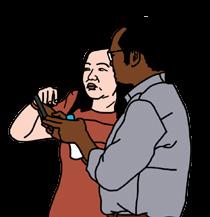
What teacher-led professional development might look like
Four Primary and two Secondary Art STAR Champions Zonal Workshops were conducted in April 2018. These workshops were intended to deepen teachers’ understanding of inquiry-based learning as a student-centred approach and provide a networking and collaboration platform for art teachers within the same zone. A selection of photographs is presented here to illustrate what teacher-led professional development might look like.
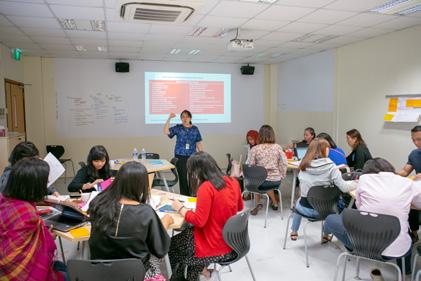
Primary Art STAR Champions got together to learn about presentation and facilitation skills, and discuss the details of the Zonal Workshops they will be leading.
Participants display their work and discuss what they have learnt. Bid Ling and Lisa can be seen in this photograph facilitating the discussion.
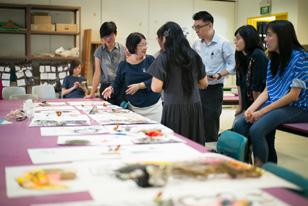

A unique feature of the Art STAR Champions Zonal workshops is a pedagogical exhibition. Here, Ting Ting leads a discussion on identifying themes, and characteristics of inquiry-based learning from the pedagogical boards.
Zabid was nominated to join the STAR Champions by his cluster superintendent this year. He stepped forward, and joined the rest of the Secondary Art STAR champions from the South and West Zones to conduct four concurrent workshops. Like the other STAR champions, Zabid shares his teaching ideas unreservedly.


In the concurrent session titled Exploring Singapore: Past, Present, Future through sculptural forms, participants experienced how the “Making Art” cards might be used to help experiment with materials and generate ideas by hands-on ‘making’.

This particular exercise also helped participants see how they might scope an elegant art task to allow students to collaborate and learn together.

Participants take a moment to share their stories at the Secondary Art STAR Champions Zonal Workshop (North and East Zones).
In the concurrent session titled Selecting appropriate artworks suitable for the syllabus focus areas, Suzana and Kerina show participants how they might use artworks of different media to ground their lesson ideas. In one exercise, they related the use of colours in Andy Goldsworthy’s ephemeral work in nature to the use of colours in Batik. Here, Suzana explains different batik techniques, and how they might be adapted for primary Art classrooms.

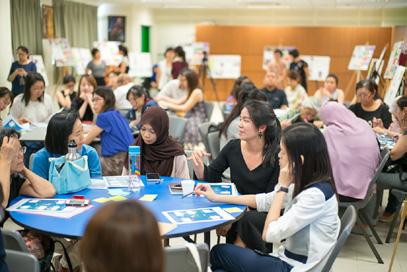
Besides the ice-breakers, the Primary Art STAR Champions Zonal Workshop (South Zone) included a segment where participants could ask the STAR Champions any question. This shows how the Zonal workshops served as a platform for participants to meet and connect with fellow art teachers.

Kai Lin peers over the shoulders of participants from the concurrent session titled Designing ICT infused art lessons. She shared that she learnt how certain applications were used. She also had a chance to reflect and improve her practice.
Teacher-Led Workshops (TLWs) are conducted by teachers for teachers. Guided by the mission of the Academy of Singapore Teachers (AST) to develop a teacher-led culture of professional excellence, AST has built on the work of Teachers’ Network to create opportunities for teachers to lead and inspire through the sharing of good practices. Through this platform, teachers will engage in professional exchange of pedagogical content knowledge, leading to enhanced pedagogical practice.
Objectives of TLWs:
Through TLWs, AST aims to:
• create platforms for teachers to lead and engage the teaching community;
• engage in professional sharing, collaborative inquiry and knowledge creation; and
• affirm and recognise the contribution of teacher facilitators.
The following are some TLWs conducted by our art teachers:
• Creative Stimulus in Artmaking through Inquiry-based Learning (Tuesday, 27 March 2018)
• Facilitating Idea Generation through Visual Puns (Tuesday, 10 April 2018)
• Learning through Play (Tuesday, 24 April 2018)
• What’s Your Trademark? (Thursday, 28 June 2018)
Read on to find out more about the behind-the-scenes planning and the reflective thoughts of our teacher-facilitators.
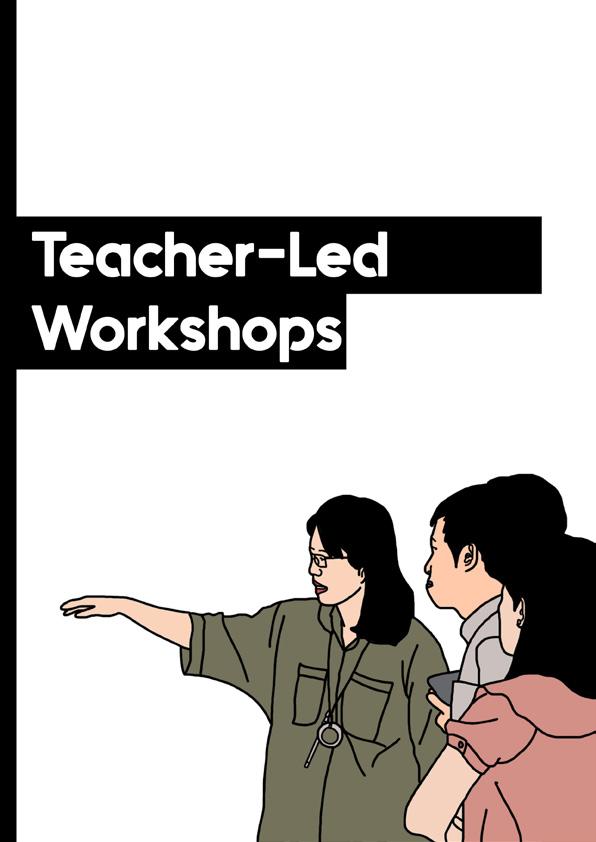
Conducted and Written by:
Ms Joyce Chia Keh Ling, Subject Head (Aesthetics) from West Spring Secondary School,
Ms Koh Bid Ling, Art Teacher from St. Gabriel’s Secondary School, and
Ms Grace Lee Wee Chin, Art Teacher from Bukit View Secondary School

Creative Stimulus in Artmaking through Inquiry-Based Learning
"Never stop dreaming, never stop believing, never give up, never stop trying, and never stop learning"
Roy
T. Bennett, The Light in the Heart

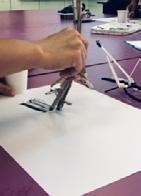
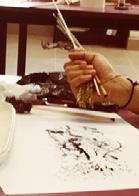
Participants touch, feel and smell the mystery bags without looking inside them, and translated their sensory experience through mark-making onto paper using the drawing tools provided.
An Art workshop for Art teachers by Art teachers
Every Art lesson is a unique experience created by the teachers. With a common vision and belief, the three of us, art teachers from different schools, came together to collaboratively facilitate this Teacher-Led Workshop (TLW).
Different creative stimulus for use during Art lessons to help make connections in the artmaking process were introduced in our TLW. These creative stimuli encourage students to loosen up as they experiment with unconventional materials to develop their ideas and concepts. Through them, they learnt that there is no wrong way in artmaking.

Our key teaching goals are to motivate and engage all learners; to find out the difficulties and challenges that each individual student is experiencing and to implement effective interventions and teaching strategies to promote every learner’s growth through inquiry-based learning.
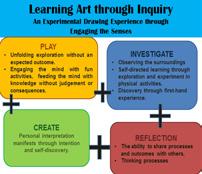
Gathering participants’ responses to understand their learning needs - A dipstick to understand the teacherparticipants’ expectations.
Act 1 -- Tapping into our senses:
Our senses help us to make individual connections with the beauty of the sensory world. Each individual would have a different response to different stimuli. The exploratory use of our senses connects our prior knowledge with everyday objects and materials. This, in turn, help us to develop distinctive expressions to articulate our thoughts and feelings. Having new sensory experiences can take us out from the mundane day-to-day and spark inspirations.
Our TLW began with a relaxation breathing exercise to get the teacher-participants to slow down and tune-in to the surroundings with their senses. Slowing down and building awareness of ourselves and our surroundings can heighten our senses and harness creativity.
After which, teacher-participants were given a mystery bag filled with objects.

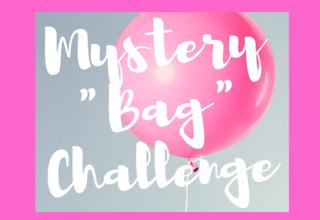
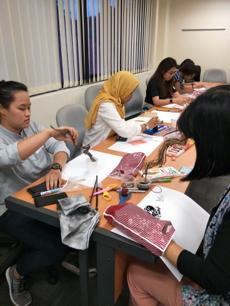
The mystery bags were then opened to reveal the surprise. This was followed by a sighted drawing (still-life drawing) of the object.



Teacher-participants role play as student learners going through the creative stimulus activity.


We ask:
"How do we get students into the main lesson activity effectively?"
"How do we 'hook' students into a lesson?"
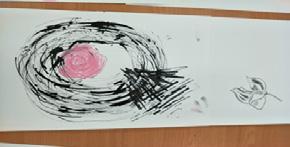
A comparison of both activities -Non-Sighted and Sighted Drawings
Teacher-participants found the non-sighted drawing increased their focusing skills and forced them to internalize proportional representation through their sense of touch and smell.
Most importantly, it helped the teacher-participants to understand that representational drawing is not all about relying only our sense of sight. Instead, we should draw what we actually feel in addition to just what we see or perceive the objects to be.

During the discussion, the teacher-participants shared that the activity had a sense of familiarity, yet there was ambiguity to arouse their curiosity due to the unexpected surprises.
Act 2 -- The ensuing collaborative artmaking activity
• Each teacher-participant was challenged with 2 verbs and 1 adverb drawn from the Making Art kit.
• Each given word acted as a catalyst to trigger critical and inventive thinking and prompt deeper thinking about the appropriate use of materials as teacher-participants created their artworks.

Collaborative artmaking
The subsequent activity saw teacher-participants working in pairs on an A2 sized paper (enabling constraint) to create an artwork based on their Making Art kit explorations of Verbs and Adverbs.
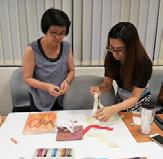

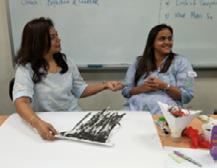
Thinking Routine: THINK.PAIR.SHARE
In pairs, teachers exchanged viewpoints by sharing their perspectives with one another. This allowed them to tap on each other’s strength and capacity to build on their own existing experiences to further enrich the learning outcomes.
We believe that through such collaborative learning, learners learn to develop and feel secure in their creative endeavours. A positive culture as such helps to contribute to selfconfidence and mutual respect for one another within the Art teachers’ fraternity.
Participants worked on their 3 prompt cards individually. After which, they shared their artwork with their shoulder partner who made a guess on the two verbs and one adverb used to create the artworks.

"Tell me and I'll forget, show me and I'll remember, involve me and I'll understand."
A Reflection -- Experience of working with and co–presenting with other teachers
Inquiry-based learning is an approach to teaching that allows students to discover, explore, create, and construct their own knowledge. It does not matter whether we are facilitators or participants, we are all unified by the IBL language. Through the common IBL language, we had meaningful interactions with fellow Art teachers and gained new ideas and inspirations to bring back to our art classrooms. We were definitely enthused by the positive contagious artistic energy throughout the sharing and learning. At the end of the day, we are all learning to become better teachers so that we can inspire the students under our charge.
"We Learn . . .
10% of what we read
20% of what we hear
30% of what we see
50% of what we see and hear
70% of what we discuss
80% of what we experience
95% of what we teach others."
William Glasser, M.D.
The Visual Pun Teacher-Led Workshop was a project that allowed me to share teaching ideas beyond school. I collaborated with my colleagues, networked with fellow art teachers and learnt to be a better facilitator.
Facilitating Idea Generation through Visual Puns

Highlights of the Visual Pun lesson unit:

1Using humour to engage students
Effective use of humour by teachers can engage students. It helps establish rapport with them and maintains their attention. Humour further helps to create an open classroom atmosphere and ease distress

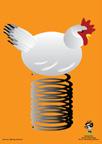




2Pun as triggers
Due to its humorous nature, a pun serves as an interesting trigger for creative thinking and idea generation. In their artmaking, students could link witty use of the English Language in everyday occurrences with flexible and clever use of images.
These Visual pun cards are designed and created by Hua Yi Art teachers. They are used as jigsaw puzzles for participants to form groups and as an icebreaker trigger activity.
3Art helps us to see things in new ways
In addition to the use of humour to capture students’ attention, the lesson unit is built using “Hybridise” and “Synthesise” conceptual design strategies (Donahue and Marshall, 2014) to support students in idea generation, simple card jigsaw and sorting games. Visible thinking routines were also used to trigger interest and guide inquiry in the lessons.

As the leader, I needed to understand the diverse developmental needs and motivations of each teacher. In addition, I needed to facilitate discussions and provide feedback to enhance the learning experiences of my team.
Being the youngest member, Ms Nora is bubbly, enthusiastic and driven to try new things. Her strength lies in building rapport with participants.


Mr Joo is grounded, consistent and patient; he also pays attention to details.
Ms Sharminee is efficient, organised and great with logistics.

Enticing and getting colleagues on board:
In order to invite my colleagues to come on board this TLW journey, I opened up my classroom to them, shared resources and modelled my lessons. I was delighted when my colleagues, Mr Joo, Miss Nora and Ms Sharminee, decided to support me in this TLW journey.
Trust is the key ingredient in my team. We know one another well and we have a healthy authentic relationship in school, supporting each other with compassion and honesty. We work towards a collective decision, and we support one another in order to make things happen.
Nonetheless, building this team took time and effort.
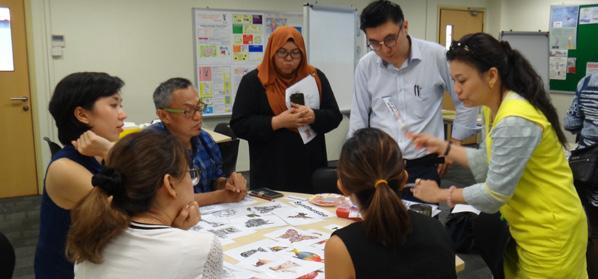
Miss Nora, Mr Joo and myself engaged in discussion with the teacher-participants in the Teacher-Led Workshop.
Reflections written by Mdm Keh Hwee Peng Irisse, Lead Teacher (Art) from Hua Yi Secondary School
Facilitating the Teacher-Led Workshop:
As a group, we established the key criteria for an effective workshop -- to cater to the participants’ needs and to value-add. We aimed to make the learning applicable and relevant so that the teacher-participants would find the time spent worthwhile.
Adult learners come with high expectations, pre-conceptions and beliefs. Information needs to be presented in a concise manner and we needed to ensure we had a clear rationale and purpose for all the learning activities.
We also empathized that our teacher-participants came after work, and would likely be feeling exhausted. Hence, we made sure that the momentum of the workshop was kept at a constant pace.
Moreover, we introduced a variety of hands-on activities and attractive visuals to keep teacher-participants engaged. Facilitation tips and pedagogical routines which can be used with students were also shared.

Through conversations and interactions with teacher-participants in the TLW, we also gained insights into their practices. Personally, I found such authentic exchanges amongst teachers rewarding.

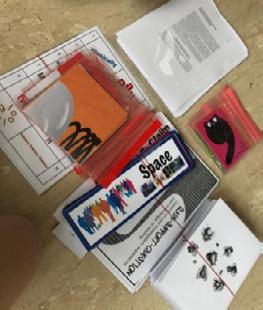
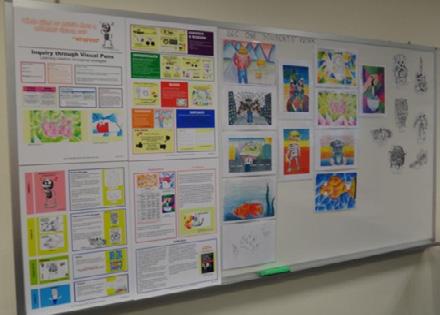

Conclusion:

The dynamism, synergy and professional relationship within our team was indeed our strength. It was the first time Mr Joo and Miss Nora shared at a national platform, and I had the privilege to mentor my fellow art colleagues. Through this experience, I was able to inspire my colleagues, empower them and promote their feelings of self-worth as they grew their teaching practices.
I truly enjoyed this TLW journey. The shared experiences brought us closer as a team. When
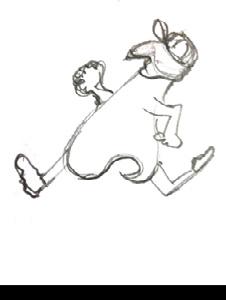
we exhibited teamwork, we modelled to other teachers the value of collaboration and taught effective teamwork by example. As mentioned by the introductory quote -- when we teach others, we gain more.
Reference: Donahue, D.M. and Marshall, J. (2014). Artcentered learning across the curriculum: Integrating contemporary art in the secondary school classroom. New York: Teachers College Press.
Variety of visuals displayed and prepared for activities
Flower bulb
created by Ms Wendy Yap Chin Ping
Learning through Play
Conducted and written by Ms Yasmine Chan (Eunoia Junior College), Mrs Vivian Tan and Ms Joyce Teo (St. Joseph’s Institution)
How it all started with PLAY
Play is an “activity engaged in for enjoyment and recreation, especially by children.” (Oxford Dictionary, 2018). In the spirit of embracing Play, we challenged ourselves to share our approaches to Play that is coupled with collaborative learning.
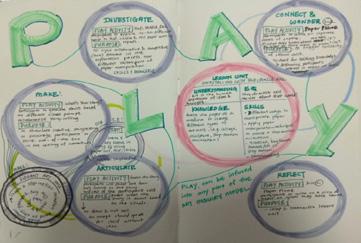

The elements of play provides a philosophical framework for illustrating the socioemotional and cognitive factors of Play.
... to Showtime!

From Planning...
Collectively, we decided to align the notion of Play with the Art Inquiry Model -- Connect & Wonder, Investigate, Make, Express and Reflect. We wanted to allow teacher-participants to experience what Play looked like in our classrooms and to redesign the lesson unit which was shared with them. Hence, Thinking Routines have to be consciously woven into our flow of activities to encourage reflective learning.


The introductory activity to launch participants into the workshop.
The first activity was designed to check for prior knowledge. Teacher-participants scribbled their answers to “How does Play look like in my classroom?” and flew them in the form of paper planes at each other to exchange responses. Some serious learners even turned to YouTube tutorials for origami planes!
Examples of paper planes produced by participants.
Our decision to co-facilitate rather than have a single lead helped us to minimize some nerves on the day of the TLW. In the first segment, teacherparticipants experienced Play as if they were students. This was followed by the segment on collaborative lesson planning to apply what they had just learnt.
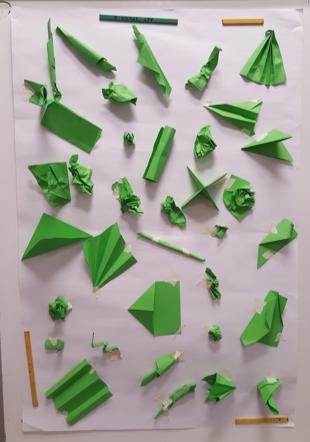
Initial attempt to incorporate Play into all parts of the Art Inquiry Model
Yasmine and Joyce facilitating a group activity.
Vivian leading a quiet time segment.
All about paper, the subsequent series of Play-infused activities brought the teacher-participants through material exploration and the possibilities of translating them into ideas and imaginative stories. We were heartened by the teacher-participants’ positive energy!
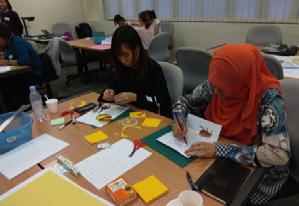


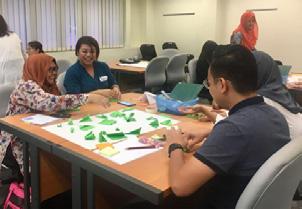

Teacher-participants during a gallery walk.
Reflections The New Collective
It was definitely challenging for us to form a “collective” of facilitators from different schools. It was difficult to find a common time for face-toface meetings. Thankfully, with technology, we overcame the challenge of time constraints by “hanging out after work” in digital environments like Google Hangouts and through using applications like Whatsapp for our discussions.
The merit of an inter-school collective is that we were able to pilot and test the lesson unit with students of different profiles and levels. For instance, the same Paper Play trigger activity of “FOLD, CRINKLE, ROLL” was conducted for lower secondary students in St. Joseph’s Institution’s 3D sculpture module. It was also used in a stop-motion animation module conducted for the students in Eunoia Junior College.
Thinking About Our Thinking
As teacher-facilitators, we learnt the importance of recognising our own metacognition. We should constantly revisit our lesson objectives and delivery strategies and be more cognizant of our own thinking. We also carried out the unit plan with different groups of students in order to seek greater clarity and to spot the gaps in our initial planning.
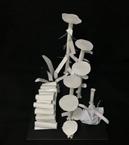
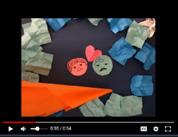
A Metacognitive Approach to Teacher Development Metacognition plays an important role in effective lesson planning. In our TLW, we modelled an inquirybased lesson and the use of various questioning strategies to promote thinking. In the process of planning, delivery and reflection of the lesson, we became more aware of our own cogitation -What strategies should be used? How to use these strategies? When should we use these strategies?
As art educators, we want our students to develop the dispositions to ask higher order thinking questions such as “What are the things that we don’t know and what questions can we ask about them?” If teachers want to teach students to be metacognitive or to think metacognitively, then teachers must first think metacognitively.
Reference:
Play. 2018. In English Oxford Living Dictionaries.com. Retrieved May 2, 2018, from https://en.oxforddictionaries.com/definition/play

Paper Sculpture by Evan Koh, St. Joseph’s Institution Screengrab of a stop-motion animation by students of Eunoia Junior College (EJVA group)
What's Your Trademark? -Enhancing Learning Experiences through Effective Facilitation
Written by Mdm Ira Wati Sukaimi, Lead Teacher (Art) from Mayflower Secondary School
Quality Teachers, Quality Education
Undergirded by the belief that the quality of an education system cannot surpass the quality of its teachers, continuous professional development (PD) is advocated to all teachers to improve different facets of their teaching processes -- educational technological advancement, content and pedagogical trends. We have a strong teacher-led culture here in Singapore. Indeed, we are privileged to access learning opportunities in different forms and also opportunities to share our teaching experiences through various platforms. The teacher-led workshops, provide opportunities for teachers to collaborate, design and facilitate learning experiences with the aim of sharing good teaching practices with their peers. These endeavours lead towards the bigger picture of improved students’ learning experience as teachers grow their expertise.
Considerations for an Effective Facilitation Plan
The Teacher-Led Workshop entitled ‘What’s Your Trademark?’ was co-developed with two other Art teachers, Erman (Swiss Cottage Secondary) and Imm Ki (Kuo Chuan Presbyterian Secondary). Through a micro-teaching approach, we aimed to have our participants experience real teaching and learning situations triggered by object-based inquiry and to create a digital logo using Adobe software. In planning the workshop, we were mindful to draw upon andragogic principles as a guiding framework to identify our instructional
aids, resources and facilitation strategies so as to create an individualized learning experience for our teacher-participants. We also wanted to bridge the theory practice nexus by unpacking theoretical and conceptual understanding with the lesson enactment.
Knowles 4 Principles of Andragogy (1984)
1Teachers need to be involved in the planning and instructional strategies for the workshop.
As adult learners, teacher-participants want to be involved in designing their learning experiences. However, it is difficult to gather input face-to-face from teacher-participants since the release of participants’ list and the lead time for workshop preparation is very short. Instead, we gleaned information from the teacher-participants via
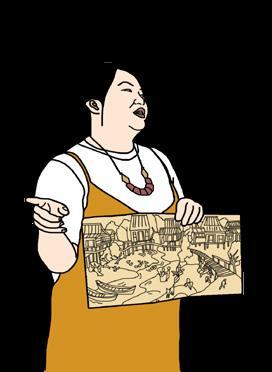
email, using a short questionnaire that invited them to share what they already knew, what they wanted to know about object-based inquiry and logo designing, and their familiarity with digital software. Their responses helped us to tweak our facilitation plan and select relevant teaching aids and resources prior to the workshop. Through this, we were better able to tailor the workshop to meet the needs of the individual participants.
2
Experiences (including mistakes) provide the basis for the learning activities.
The collective and rich experiences that our teacher-participants bring to the workshop form the basis for the learning activities in the workshop. For the micro-teaching segments of each teaching action, we as facilitators would pause to unpack the metacognition and rationale that led to the learning design. Teacherparticipants would be invited to share their experiences of how they taught similar topics/ content in their own art classrooms. They would be further invited to suggest improvements to the micro lesson taught. This is an important step for both facilitators and teacher-participants to co-construct new knowledge, reassess and reinterpret their own prior understanding about how the concept, topic and content could be taught in a more student-centred approach.
3
Adults are most interested in learning subjects that have immediate relevance and impact to their job or personal life.
It is pertinent to outline and unpack the learning outcomes and itinerary at the start of the workshop. Teacher-participants need to understand the Why, How and What of the session. This will help them see the relevance of the learning outcomes to their work as art educators and the impact their learning would have on their charges in school. Only then will our teacher-participants be more ready to integrate new ideas gleaned from the workshop with what they already know and connect existing knowledge and experiences with new concepts and processes.
4Adult learning is problem-centered rather than content-oriented.
As professionals, teacher-participants are wellequipped with content mastery. Our teacherparticipants come to learn strategies to teach content better. In cognizance with the national narrative of inquiry-driven and student-centred approach to teaching, teachers are actively finding ways to improve their teaching actions. Some questions that were raised include ‘How do we start’, ‘What triggers can we use’ and ‘How to pique students’ interest’. Teachers want to gain concrete skills that they can apply directly to their teaching practice.
Conclusion
Rich learning coupled with a comfortable venue, sufficient breaks, a safe space and good time management are part and parcel of a good workshop. It is not about drawing up a foolproof facilitation plan, but more pertinent for us as facilitators is to assess the workshop situation and understand participants’ needs to establish how much self-direction and guided inquiry should be presented. At the end of the day, the learning outcomes and the participants should still be at the centre of our planning.
Reference:
Knowles, M. S. (1984). Andragogy in action – Applying modern principles of adult learning. San Francisco: Jossey-Bass.
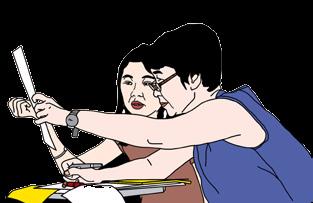
Share at Teacher-Led Workshops
Teachers are invited to share your good practices with others in the fraternity. The proposed TLW must be minimally shared at school-based platforms before. For those who are interested, please access and complete the online application form via the link https://tinyurl. com/tlws2019 or via the attached QR code.
All online application forms are to be submitted by Friday, 20 July 2018. If the main and co-facilitator(s) are from different schools, co-facilitator(s) would have to ensure that his/her Principal is informed and supportive of the TLW application.



Connecting Art. Weaving Values. Joyful Learning.
Written by Mdm Lee Gim Fang, Subject Head (Visual Arts) from Lianhua Primary School
Over the years, food waste has grown to be a critical environmental issue in Singapore and around the world as people become more affluent and have wider food choices. I believe that teachers play an important role in educating our students about this concern and the consequences of food waste. According to Eisner (2002), Arts can impart life-long lessons to our young. I want my students to empathise with the issue and adopt social responsibility to influence the people around them to reduce wastage of our Earth’s resources. Here, I will share the key focuses of my Primary 4 Food Waste Sculpture module and how it helped to inculcate 21st Century Competencies (21CC) and enhance socialemotional learning in my students.
The four key focuses of the Food Waste module:
1
Build environmental awareness through artmaking: To help my students realize that food waste is a real problem, I encouraged them to make observations of food waste happening at the school canteen and their surroundings. They went on to research on food waste issues to gain a deeper understanding of the environmental consequences. Their research in turn informed their conceptualization of ideas for their food waste sculpture.

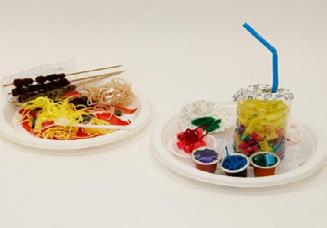
2
Encourage critical and inventive thinking: Students generated different ideas and explored ways to communicate them through the use of various non-traditional materials. As the students worked in groups, they learnt to review, reinvent, reflect and discover creative ways to create their sculpture.
3
Inculcate civic literacy and global awareness: In addition to helping students draw inspiration from their environment, I also introduced artists from other cultures and contexts to enable them to make connections and understand the value of art in their lives and society. During the artistic inquiry process, my students learnt and studied how contemporary artist, Itamar Gilboa, expressed opinions about food issues through his artwork – The Food Chain Project.
4
Inculcate school values through artmaking process: Throughout this inquirybased learning process, students had the autonomy to choose materials and working methods to create authentic responses and to actualize their plans on educating others about food waste reduction. By doing so, students acquired values such as teamwork, resilience, diligence, self-discipline, empathy and motivation to excel.


"Through
my research, I learnt that food waste exists in other countries besides Singapore. I believe that all of us can make a difference to reduce food waste around us if we understand that food is precious and do not take it for granted. Hence, I hope that when others look at my group's sculpture, it would encourage them to stop food waste and cherish the food they eat."
- Kim Kyung
Exploratory works with materials by students using the Making Art Kit
Students exploring non-traditional materials in groups using Making Art Kit.
Hyeon, P4 Loyalty P4 Food Waste Sculptures constructed by students
Feedback from the P4 students:
Feedback from colleagues:
“ During the Making Art - Verb + Materials game, I learnt new ideas together with my team members as we explored various methods to use different types of materials to create the food items. Although it was challenging at first, we practised our school value -- resilience and persevered on. In the end, we discovered creative ways to fold the paper to create the items.”
- Park Boeun, P4 Loyalty
“Through these Art lessons, an existing global social issue was used to create awareness amongst the student community. Giving students the autonomy in material selection encouraged the spirit of exploration, experimentation and innovation. There is potential in how art could become a platform to impact the community positively."
- Ms Chen Yimeng Vivian
“ It helped to raise students' awareness on the use of recyclable materials in their artmaking. Giving students the choice to select materials actually built up their confidence to become independent learners."
- Mdm Azizah Mohd Ali
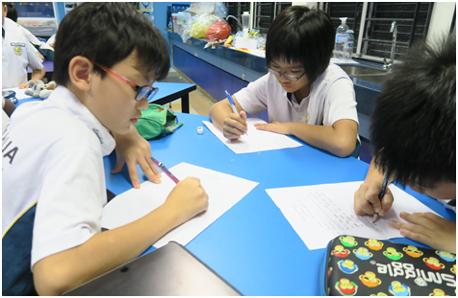
“ I learnt to be patient and to listen attentively to my peers when they presented their ideas. Also, I learnt to accept different opinions from my team members as we discussed and analyzed the artwork The Food Chain Project by Itamar Gilboa. I think it was amazing to learn how he created 6000 food sculptures based on what he ate in a year to raise awareness for food waste through art.
- Tiew Yun Hui Philena, P4 Loyalty
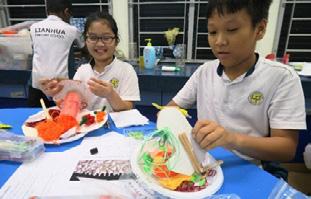

Eisner (2002) noted that Arts evoke, develop and refine unique modes of thinking. As an Art teacher, I believe that art can engage my students’ imagination and creativity by inspiring them to innovate as they discover and experiment. It is also important for students to engage in real world issues through artmaking. It was heartening when I noticed the 21CC exhibited by my students and the practice of good SEL skills and school values throughout their artmaking process. Students developed critical thinking skills, became more open to new ideas and were more receptive towards different opinions. They also displayed greater confidence in articulating their viewpoints and became more self-directed in their learning as they took up the responsibility to research on food waste issues. In doing so, students learnt to be empathetic towards social and environmental issues. They expressed their thoughts, concerns and raised possible solutions when they learnt about the huge amount of food wasted in Singapore and
the impact on the environment. They hoped through their food waste sculptures, they could make a difference by encouraging their peers to cherish food.
To conclude, we are not merely Art teachers in the classroom. Instead we are advocates who connect our students to the world around them. We sensitize them to pertinent environmental and social issues through the learning of art. I work towards instilling in my students social responsibility which will guide them to learn that they can make a difference to create a more humane world, caring not just for oneself, but for the people and environment around them.
Reference:
Eisner, E. (2002). The arts and the creation of mind. Yale University Press.
Students reflecting on their learning.
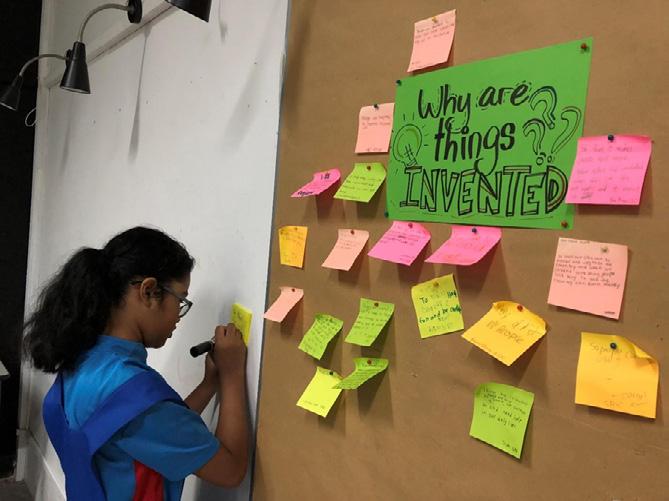
Creating a Vibrant Art Culture in School: Motivating Students to Create Art Beyond the Classroom
Written by Mrs. Rachel Tay, Art Teacher from Rivervale Primary School
" Exhibition is a process that promotes collaboration, sparks motivation, widens understanding, and creates partnerships ranging from individuals to the community."
- Burton, 2004
Increasingly, we see schools dedicating spaces to display student artworks. We, at Rivervale Primary School, also have our designated art display area, a room fondly referred to as the ‘Art Hub’. In addition to featuring student artworks and termly exhibitions, the Art Hub is conceptualized as a place for students to create art and be engaged in various artmaking activities. The Art Hub is open to students during their recess time, and our Art teachers are present to facilitate different activities. Although some activities are facilitated by the teachers, we have also put up other artmaking ideas in order to encourage students to work independently. Since the first semester of this year, students have tried their hands at character designing, doodling, Impressionist art appreciation and Chinese New Year décor making, just to name a few.
As a teacher who was new to the school because of cross-level deployment from a secondary school, I initially found the concept to be refreshing yet at the same time a little daunting. My initial concern was how we could motivate our students to come to the Art Hub regularly. Working together with other Art teachers in the school, we observed that students who love Art are naturally inclined to attend, and through consistent updates of the hub’s activities, the curiosity of other students who were not as interested at first was ignited as well. Selfmotivation to create art is, therefore, a key consideration in our plans to draw students to the Art Hub.
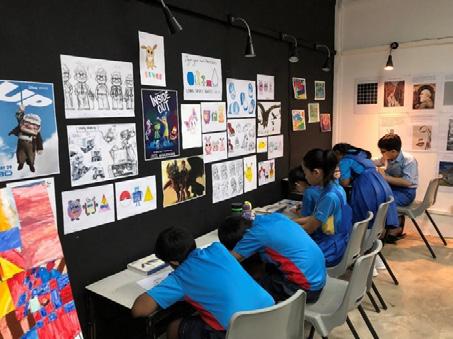
how they want to be engaged -- that sets our students at ease and allows them to enjoy the art experience. By encouraging such autonomy, we are able to encourage our students to engage in art for their personal enjoyment beyond lesson time. The following are written reflections by three primary five students who are regulars at the Art Hub:
Autonomy, Competence and Relatedness in consideration with the Art Hub activities
Having prioritized the role of self-motivation to create art as a key driving factor for student attendance at the Art Hub, we used the selfdetermination theory to guide our planning and facilitation of the hub’s daily art activities. Self-determination theory proposes that people have three innate psychological needs that are considered as universal necessities for motivation, namely: Autonomy, Relatedness and Competence. (Deci and Ryan, 2000).
Autonomy is having a sense of free will when doing something or acting out of our own interests and values (Merriam-Webster’s collegiate dictionary, 1999). At the Art Hub, students are not obliged to take part in the artmaking activities; instead they may choose to simply view the exhibits or create their own sketches. As far as possible, we provide students with some freedom of choice in order to promote learner autonomy. We believe that it is the freedom of choice -- in deciding
"I like drawing so I like coming to the Art Hub. There is also an artist of the month quiz."
– Caven, Primary 5.
"I like seeing the artworks made by my schoolmates. I will pick and choose my favourites and try to follow the styles."
– Imran, Primary 5.
Students designing their own characters, using Disney and Pixar animations as references at the Art Hub.
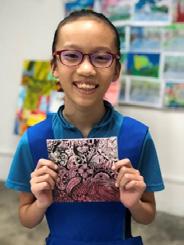
"Art Hub helps me to relieve stress. I feel very happy and I like coming to the Art Hub. I like colouring."
– Jeslyn, Primary 5.
According to Deci and Ryan (2000), relatedness is characterized by the desire to be socially connected and a need to experience genuine social relationships with others. At the Art Hub, we provide opportunities for our students to connect with their peers through structured conversations on the artworks. Our upper primary students discuss and analyse artworks
for open discussions and exchanges through art, we are a step closer towards nurturing a closely knit student community.
Students used inquiry-based thinking routine -- Compare and Contrast, to analyse the similarities and differences among the self-portraits exhibited by the Primary 6 cohort.
The daily activities at the Art Hub provide teachers with an avenue to communicate with students, acknowledge their perspectives and create a learning environment that is safe, warm and supportive. The teachers also get feedback on the types of activities our students would like to see in the Art Hub, and we constantly review the students’ suggestions in order to improve the Art Hub experience. Though we may not implement every suggestion, we value this platform for communication as we are able to use the time to meaningfully respond to students’ comments and questions about artmaking. A much requested activity by the students has been Manga Drawing, and it has been scheduled to take place in Term 3.



As for the third component of the selfdetermination theory – competence, we develop it through enabling our students to experience personal success in their artmaking. The work done at Art Hub is not graded nor evaluated, and we use positive feedback to recognize the students’ efforts. According to Deci (2000), positive feedback helps to satisfy one’s need for competence which in turn reinforces intrinsic motivation. We feel that it is important to steer away from taking an evaluative stance for the work created at the Art Hub. The focus is on getting our students to be intrinsically motivated, so that they are not making art merely for a grade. We use the opportunity to give recognition for effort and the time spent to make improvement. Enjoyment of the work itself, genuine personal achievement and growth are some of our key motivators.
Having this added time to interact with students at the Art Hub has proven to be beneficial for the teachers. We were able to discover what our students wanted to learn and what they were interested in when it comes to artmaking.
The Art Hub allows focused interaction with our students beyond Art lessons and provides a platform for teachers to cater to their need for autonomy, relatedness and competence. Motivation being an important aspect of learning goes a long way in developing an individual’s aptitude and interest in the subject.
Teachers have an important role in fostering a vibrant art culture in the school, and I believe that in order not to short-change our students, we have to constantly find ways to breathe life into an otherwise structured approach of creating art within the one-hour timeframe of a typical Art lesson. We can make deliberate choices and create opportunities that require students to behave autonomously, connect with others, and feel a sense of personal competence and growth, within the classroom and outside of it as well.
References:
Autonomy. 2018. In Merriam-Webster.com. Retrieved May 1, 2018, from http://www.merriamwebster.com/dictionary/autonomy
Burton, D. (2004). Exhibiting student art. Art Education, 57(6), 41-46.
Ryan, R. M., & Deci, E. L. (2000). Self-determination theory and the facilitation of intrinsic motivation, social development, and well-being. American Psychologist, 55(1), 68-78.
Jeslyn enjoys taking part in the activities, and she finds greater delight in spending time to create her own art.
Connect to Art, Connect through Art
Written by Mdm Chun Wee San, Head of Department (Aesthetics) from Boon Lay Garden Primary School
"I was touched to see my students put in their best efforts to create art together. Each gear design represents the student's ideas about his/her school experience. Both my students and I have learnt much from our involvement in the BLGPS40 Art Series Project."
- Mdm Siti Noorazian Ismail, Art Teacher
At Boon Lay Garden Primary School (BLGPS), we endeavour to build a vibrant community of Arts learners and appreciators. This vision hinges on our belief that the Arts can touch lives in profound ways, and we strive to tap on this transformative power of the arts to impact the lives of people in our school community. We dedicate ourselves to making engaging and empowering Arts learning experiences accessible to our students, to lay the foundation for a lifelong interest in the Arts. One such Arts experiences is the “BLGPS40 Art Series Project” which we carried out in 2017.
2017 was a very special year for BLGPS as we celebrated our 40th anniversary. It marked yet another significant milestone for the school, as we continue the important work of nurturing Thinkers, Leaders and Contributors, building on the legacy of BLGPS. To commemorate this happy occasion, the whole school embarked on an artistic journey to create artworks that expressed our hopes and aspirations for the school. Entitled “BLGPS40 Art Series Project”, it brought together different groups of people - students, staff and parents - to share their stories, ideas and perspectives through art. It was the joy of making art together, the synergy through collaboration, and the esprit de corps that we experienced in the process that made this project a truly meaningful and memorable

A prominent feature in the “BLGPS40 Art Series” is the gear shape which project participants transformed based on their interpretation of different themes. The gear shape has a special significance for the school. A key element in the school crest, the gear shape is a symbol of industry and signifies the concerted effort to bring out the best in every child. In a similar vein, the “BLGPS40 Art Series Project” brought out the artist in every one of us and unleashed the creative potential that reside within us.


Primary 2 – Celebrations: A Kaleidoscope of Colours
Inspired by Kandinsky and Matisse, Primary 2 students played with different materials and used a variety of lines, shapes and colours to create mixed-media collages that convey the spirit of celebration.
Upon completion, selected artworks were assembled, framed (eight square panels of beautifully designed gear shapes) and proudly showcased at the school’s Homecoming Dinner on 30 June 2017 and the BLGPS40 Concert on 22 September 2017. They brought much delight to the viewers who were seen admiring

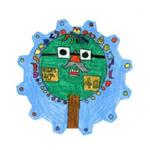
Primary 4 – Expressions of Innovation and Imagination
Thinking Curriculum through Habits of Mind@BLGPS is the school’s Applied Learning Programme. One of the Habits of Mind that Primary 4 students focuses on is “Creating, Imagining and Innovating”. For this art project, the Art teachers adapted the Vormator Challenge* and designed a task in which students were required to create interesting gear designs using only 8 shapes. With a limited palette of shapes, students had to problem-solve and explore possibilities.
* Vormator is a design challenge that requires artists
and talking about the artworks. These brightly coloured artworks also became a wonderful backdrop for many selfies and wefies!
Engaging with different themes
Primary 1 – My School: The Garden where Diversity Blossoms
Primary 2 – Celebrations: A Kaleidoscope of Colours
Primary 3 – Joy of Learning at BLGPS
Primary 4 – Expressions of Innovation and Imagination
Primary 5 – The BLGPS Heartbeat: Our CARES Values
Primary 6 – Creating the Future: My Hopes for BLGPS
Staff – Together We Nurture for a Better Future Parents & Child – A Tie that Binds
The “BLGPS40 Art Series Project” was one of the ways we connected people and built communities through the Arts. It is our belief that when we engage with different perspectives and ideas presented through the Arts, we learn
"The art project has allowed me to be creative and express my own ideas!"
- Lee Jia Sheng, P4-6



Primary 5 – The BLGPS Heartbeat: Our CARES Values*
Students learnt to communicate their ideas using symbolic images. For instance, the students used blooming flowers to represent the nurturing of sound school values, and interconnected people to show cooperation and teamwork.
*CARES Values: Cooperation amongst all, A*Attitude, Respect for all, Effort leading to Success in everything that we do


to better understand ourselves and the world around us, and develop an appreciation that there are different ways to view and interpret the world.
As part of the school’s community engagement efforts, we also connected with the Boon Lay community through the Arts. On 19 May 2018, we invited the residents of Boon Lay to join us for a morning of artmaking. Facilitated by our Art Club students, the project provided an opportunity for bonding between Boon Lay residents and students of BLGPS. It also aimed to contribute to building a culture of community artmaking and Arts appreciation in our neighbourhood. The project allowed students to apply their art learning in an authentic context and develop important values such as empathy, respect, cooperation, as they taught the residents a new art form and created art together. This initiative supports our school’s continual efforts to develop our students as active contributors, by providing them with opportunities to bring joy through art and share their talents for the benefit of others. The artworks will be displayed at the school’s inaugural external art exhibition in August. Themed “Our Neighbourhood”, the exhibition will feature artworks that depict the people and places in the neighbourhood. This will be an art exhibition that is about the community, by the community, and for the community.
Making art together, especially for a common purpose, provides a shared experience for the students and staff; and when extended to the neighbourhood, it contributes to enriching community lives and fostering closer bonds. A student shared that she was proud to be part of the “BLGPS40 Art Series Project”, and a resident joyfully asked when our next art workshop would be. Indeed, the journey ahead is an exciting one and the possibilities are many. We look forward to more artful experiences where we connect people through creative and collaborative endeavours!
Top: P1, P2, P3, P4
Bottom: P5, P6, Staff, Parents & Child
The Crest Visual Arts Narrative: Cultivating Growth for N(T) Students through Redesigning Curriculum
Written by Ms Lisa Lok, Subject Head (Visual Arts) and Mr Matthias Chua, Head of Department (Aesthetics and Publicity) from Crest Secondary School
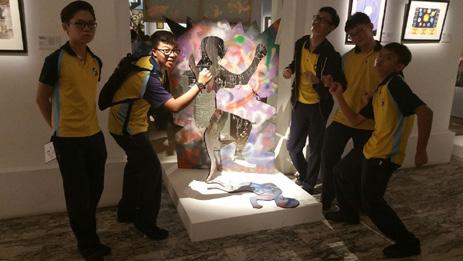
Introduction - Navigating The Seas Of Growth
Crest Secondary School is a specialized school for Normal Technical N(T) students. The profile of N(T) students tends to consist of low progress learners from families with lower socioeconomic status. The average T-scores of Crest students are relatively lower than N(T) students in mainstream schools. Hence, this implies that the academic abilities of the students are lower at the point of Secondary 1 intake.
Having mentioned this, as a school, we believe in the growth mindset and that abilities and intelligence can be developed (Dweck, 2006). Dweck’s research shows that students can grow their abilities as long as they put in extra time and effort. This in turn will lead to higher achievement. This is the basis of why in Crest, it is important for us teachers to believe that every student is a unique individual who is capable of learning and excelling. This belief motivates us
to focus on how we can facilitate the growth of the students’ abilities through curriculum design. We believe that the key for growth is not about encouraging this group of students with low motivation to put in more effort, (which is a slight deviation from Dweck’s work) but through careful thought in curriculum design. We feel that this is the key to what Dweck, Walton & Cohen (2014) term as “unlock learning in students”.
Here we will share how we unlocked learning through student engagement by the purposeful crafting of our classroom processes and how we created an experience for learning, which led to growth. Thereafter, we will share the programme framework which connected the dots together.
Transforming curriculum encounters to student engagement
We feel that the key to unlock learning is engagement. Saphier, Haley-Speca & Gower, (2008) positioned engagement as the precursor to high success in learning and they went on to describe it as “a composite of interest, concentration and enjoyment” (p. 53). This gave us a direction to begin. In schools,

we parcel out different pockets of time for the learning of different subjects, termed as encounters. An encounter does not necessarily mean that student engagement has taken place. Furthermore, as teachers we also know that when students are busy doing something, it is at best described that they are on task. Yet, learning may not have taken place. But when a student is interested in what they are doing, find meaning in their work and want to do it better, there will be the motivation to learn, and thus, to grow.
In the subject of Art, the teaching of Elements of Art and Principles of Design needs to be consciously embedded into authentic tasks.

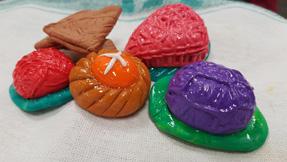



Students as artists participating in SYF Art Exhibition.
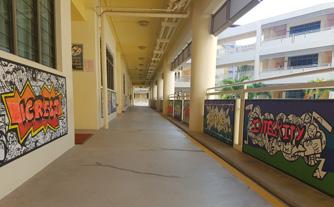

The Art modules are designed in a way to make learning visible. The challenge is to make the students find the skills useful and therefore want to be better in them (Dweck et al., 2014). This “how” helps to increase the engagement level and thus, the motivational level to learn. In our lower secondary curriculum, we incorporate a mixture of conventional and unconventional media in authentic tasks to engage the students. Instead of drawing on paper, we give students coasters, paper bags, caps and even masks. We design tasks using these to teach lines, colours and design concepts.
We want our students to find the Art lessons meaningful and authentic, creating art that they can use or even wear. Their artworks or products are associated with themselves and their individual identity. Thus, there is a huge incentive for the students to produce their work to their best ability. As a result, the motivation to do well is more than their concern for their assessment grades. In the process, students show evidence of experiencing enjoyment in learning “as an ongoing process which provides rewarding experiences in the present” (Csikszentmihalyi, 1975, p. 9). This eagerness to do well lays the foundation for growth. It is also important for teachers to uphold standards and encourage students to strive to meet expectations. As students are determined to do well in their work, they experience positivity in the form of personal engagement in their learning.
Our Secondary Three Aesthetics Elective also focuses on the ideas of authentic learning experience and engagement. A broad range of 2D and 3D media are offered to them. Students

got to choose modules such as iDesign and Let’s Go Local, where they took on the role of product designers to create products to promote local food, culture and heritage. In Toy Photography, they took on roles such as photographers and animators seeking to create their own series of motivational posters and postcards. In these modules, students learnt and applied design principles to create artworks that were functional, useful and had retail value.
All completed artworks (both lower and upper secondary) were made into corporate gifts for school visitors or they were curated and exhibited around the school. For example, artworks from the colour wheels module were turned into a Garden Installation Art, whilst works from the canvas module were framed and displayed in the school Bistro. From the application of art skills, functional use of the artworks, to the curation and installation process, our students were involved right from the start. Many of them reflected that they
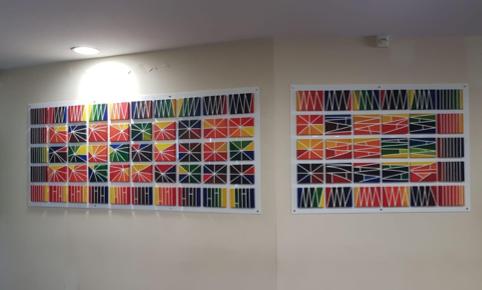



Doodling Art mounted along the classrooms corridors.
Students installing colour wheels
Canvas Painting at the school Bistro.
Masks Display
Dream Job Mural and Colour Wheels Installation
Students as teacher assistants at a school event
Student Tay Shijie presenting a corporate gift to Ms Sulian Tay. Standing next to her is our Principal Mr Seet.

had never had their works exhibited before. Incorporating authentic tasks that led to meaningful outcomes gave students the added motivation to ensure their work was well done. The purposeful design of the curriculum helped to surface the learning and make it visible.
A proper scaffolding process must be put in place to effectively support students’ successful learning (Wood & Ross, 1976). Scaffolding is not only essential in giving the support in a timely, needful and well thought out manner. More importantly, effective scaffolding helps to increase students’ motivational levels (Dweck et al., 2014). This is a critical consideration in our lesson design -- we ensured that there was a gradual and timely unfolding of concepts in the prescribed tasks that were challenging yet manageable within their abilities. Thus, we helped our students to experience incremental successes.
Creating conducive learning spaces also helped to support student engagement by enhancing their learning experiences. Our various learning spaces are designed to provide a total learning experience for the different modules.
Evolving from engaging lesson to a learning experience
At Crest, we strive to make the art experience holistic with cognitive, emotional and relationship aspects. Through team-based project work such as doodling art, groups of 4 to 5 students worked together to create pieces of doodle art on wooden panels. Through this activity, students gained the experience of coming together to collaborate. This in turn provided students the opportunity to experience a positive collaborative relationship, which many of them had not experienced previously.
For a component in “Artists’ Expression”, we invited every student to articulate why they liked their own or their friend’s artwork. Tapping on technology, they also created their art portfolio using iPads and recorded videos with audio recordings of their Artists’ Expression on their sets of artworks. This formed part of the students’ assessment and it also gave students a platform to express their thoughts and feelings about the artmaking process. (See Student : Ziqry’s from class 2-1 Artists’ Expression video attached). Through this, we helped students to:
1. find out what they are good at and feel a sense of pride (emotional),
2. reflect and articulate what works in their art piece and what decisions they could have made to enhance their final product (cognitive), and
3. praise their friend’s work (relationship).
Hence, this “Artists’ Expression” provides a composite learning experience for the students to grow in character, interpersonal relationship and skills.
Conclusion: Cultivating Growth

Every meeting with students (whether during class time, CCA time or informal settings), was

an encounter which provided teachers the opportunity to engage students. Successful engagement sets the groundwork for cultivating a learning experience which in turn leads to growth. Both the engagement and learning experiences need deep thinking taking into consideration the type of learners, their profiles and their learning needs. There will be a constant evolution of the curriculum design, plans and activities as the students’ profile and learning experiences evolve.
One example of this, is that collectively as a department, we noticed that there is a growing group of students who have shown talent and skills in Art. To engage them, an art talent development programme was set up. This later evolved into the Visual Arts club. In this programme, we created learning experiences outside the classroom. This includes inviting the club to help out in the school’s art events, such as getting students to be teacher assistants, getting them to participate in community art wall murals, creating postcards for SGSecure whilst learning alongside art practitioners, and participating in SYF as artists.
Due to the extensive requirements of the art projects, these learning experiences go beyond what could be taught in the classroom. They learnt the need for rigour in creating artworks, to strive towards excellence and learnt about teamwork as well. The exposure, interactions and recognitions within the art community helped them to grow in confidence whilst


working alongside their peers, teachers and art practitioners.
Fundamentally, we believe that every student can learn and grow. As teachers, we have the important responsibility to work collectively and skillfully design programmes and opportunities to generate growth within our students. The process is challenging for us as teachers, but every time our students taste small learning successes, we also make small wins in our teaching endeavours.
References:
Csikszentmihalyi, M. (1975). Beyond boredom and anxiety. San Francisco: Jossey-Bass Publishers.
Dweck, C. S. (2006). Mindset: The new psychology of success. New York: Random House.
Dweck, C. S, Walton, G. M & Cohen, G.L. (2014). Academic tenacity: Mindsets and skills that promote long-term learning. Bill and Melinda Gates Foundation.
Saphier, Jon, Haley-Speca, A., Mary, & Gower, Robert, (2008). The skillful teacher: Building your teaching skills. Acton, MA : Research for Better Teaching, Inc.,
Wood, D., Bruner, J. S., & Ross, G. (1976). The role of tutoring in problem solving. Child Psychology & Psychiatry & Allied Disciplines, 17(2), 89-100.
Yeager, D. S. & Dweck, C. S. (2012), Mindsets that promote resilience: When students believe that personal characteristics can be developed. American Psychological Association, 302-314.
Students as apprentices learning from art practitioners.
Student Ziqry’s video
Click on image to play video Crest Aesthetics Programme Framework
Artists Lab with Art Box concept serves as a classroom.
The Analogy of Networked Learning Community (NLC)
Written by Mr Chia Wei Hou, Senior Techer from Raffles Institution
Allow me to employ an analogy: a teacher is like a doctor. Like what a doctor does, a teacher performs diagnosis on the patient’s, or in this case, a student’s ‘ailment’ or ‘pathology’ in the form of ‘learning problem’. I have always been drawn to the idea that a teacher is indeed doing important work parallel to that of a doctor. Teachers are often tasked with locating the students’ pathologies, and have to quickly determine a set of effective interventions and act on it in order to ‘cure’ or rid the ‘learning problem’.
able to administrate the correct intervention or treatment for all at a go? The only possible time that a real doctor could find himself in this similar situation is during a disaster.
Still keeping to the ‘doctor analogy’, a doctor could practice as a private general practitioner, working within the confines of his clinic and seeing patients in and out, repeating the routine of diagnosing the patient, determining the cause of illness and providing medication

What I am suggesting here however, is that teachers find themselves with a more difficult and challenging job than doctors, because doctors attend to a single patient at any one time, whereas teachers are in a classroom full of students, ranging from 10 to 30 students or even more. Even if teachers are able to locate the pathologies for all the students, which is already an amazing feat, how are the teachers
to remedy it. The trade-off is that the doctor might feel cut-off from the outside world and the field or the discipline itself. Unless the doctor is able to maintain currencies of the latest trend and medical practices and procedures, he or she is not able to upgrade his/her skills and knowledge to provide care and treatment.
Just imagine the possibility if all the individual doctors could come together to share on the cause and the methods of treatment of
a particular ailment, such as the flu. From the collective data and information pooled together by the doctors, even though they may not be able to eradicate the illness completely, they will be able to increase the odds of finding an effective cure for the patient.
In all likelihood, people fall sick in more or less in the same manner. In other words, we catch a cold for the same reason—that is why it is called the ‘common flu’. That makes it easier for doctors to share their experiences and treatment, using the ‘common’ data and work towards having a ‘concerted’ and ‘focused’ effort to perform interventions.
Teachers, like doctors, can find themselves in a similar situation where they are confined within their classroom, cut off from the rest of the fraternity, busily seeing one patient after another. Unless there are means or platforms where teachers can link up and connect with other teachers, they will remain fixated within their small sphere of influence, no matter how effective or efficient their treatment might be. That is the reason for having collaborative platforms such as Community of Practices (CoP), Learning Circles, Professional Learning Communities, or Networked Learning Communities—because students ‘fall sick (more or less) in the same manner’ no matter what intellectual calibre they are. By having common knowledge of the methods of treatment allows for an accelerated recovery from the aliment. By working together, teachers can change their classroom practice and improve on students’ learning.
This is the basis for the formation of a NLC for the ‘A’ Level Art Teachers fraternity—the desire to pool together what is already a very ‘petite’ group of Art teachers teaching in JCs and CI to collaborate across schools in a very intentional and deliberate manner. The NLC serves as a ‘site’ whereby Art teachers from JCs and CI can connect with each other and share ideas and teaching practices, so as to create new knowledge and affect deep changes in classroom practices.
On 29th Jun 2017, Art teachers from almost all JCs and CI came together with the prospect of formalising an NLC for ‘A’ Level Art Teachers.
During the meeting, some Art teachers volunteered to share teaching and learning issues and concerns that they encountered in their classrooms, with focus on the teaching of Study of Visual Arts (SoVA) component. Concerns such as how to make the learning of theory more interesting and engaging, ways to assess the quality of writing etc., were all real student learning needs that the JC Art teachers have encountered in their classrooms. Vivid and candid exchanges and recommendations to each other based on their own personal experiences in confronting the similar issues and problems, transformed the whole meeting into an ‘operating theatre’ where a group of ‘doctors’ congregated to discuss on the learning aliment that they had ‘witnessed’. What was enthralling was the fact that all Art teachers did away with the competition amongst schools and thought as one fraternity to fight against the ‘common flu’.
That was not the first time JC and CI Art teachers gathered to meet for sharing and exchanges. In fact, previous meetings laid an important foundation to establish a conducive condition for a more deliberated and structured learning community that focused on networked
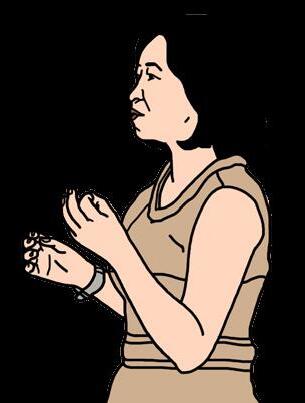

exchanges and sharing between Art teachers from different schools. What could distinguish the NLC from other kinds of sharing that took part between the JCs and CI Art teachers would be that NLC participants work closely together to:
1. solve problems encountered by teachers in the teaching of the ‘A’ Level Art syllabus
2. gather evidence from observations and research
3. open up the knowledge for scrutiny and discussion by making their knowledge explicit and public
4. create new knowledge through the collaborative inquiry
Hence, this NLC is different from the sharing of learning that every teacher is doing within the confines of their individual schools. NLCs call for participants to learn from each other and learn with others, so as to achieve some form of learning on behalf of the fraternity. The biggest challenge confronting any NLCs would be for the participating teachers to remain open to new ideas and unfamiliar knowledge, and change the way they think and teach.
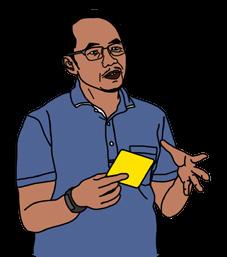
A handful of Art teachers met again on the 27th Nov 2017 to discuss deeper topics of collaborative inquiry that this NLC had intended to support, in order to formulate possible shared learning objectives that could possibly transform the professional knowledge and the teaching practices in the classroom.
The NLC is still in its infancy stage, where subsequent developments will see the fulfilment of various pockets of networked groupings of Art teachers looking into ‘dissecting’ various themes and initiatives in teaching and learning of Art at ‘A’ Level. The learning community should not be seen as an end in itself; it should be perceived as an ongoing, continuous process of having conversations to examine problems, propose new ideas and formulate new solutions so as to achieve the goal of helping our students learn Art in the most efficient way.

A snapshot of how 2017 P1 Art-EL lesson unit looked like – encouraging questioning and investigating through exploration of PowerPoint tool for art-making; leveraging on peer coaching to promote learning conversations and build on ICT skills; and activating students as assessors of own and peer’s learning using guided question prompts. Students shared about their artwork, My Imaginary Creature, during Show-and-Tell presentation during English lessons.
Creating a Culture of Thinking through Interdisciplinary Connections
Written by Mdm Gan Ai Lee (Subject Head, Art) and Mrs Goh-Wong Wei Ling (Level Head, English), from Endeavour Primary School
Akey focus in our school is to nurture thinkers through knowledge-building practices, to develop an inquiring disposition in our learners and teachers through inquiry-based approach by making thinking visible. With the infusion of thinking routines into our Art, EL and Maths curriculum, a thought that lingered in our mind was how integrated instruction might help us better utilise the instructional time and allow for authentic assessment, to promote an inquirybased culture across disciplines.
In 2017, the Art-EL collaboration explored the possibility of using artworks created by Primary One students as artefacts for Show-andTell presentations, which was part of English assessment. This integrated approach would allow students to tap on the rich learning conversations and thought processes made visible during Art lessons for the presentation. English teachers could also better utilise their instructional time to help students hone their presentation instead of preparing a prop. The collaboration was the beginning of an interdisciplinary approach to inquiry-based learning.
In this Art-EL collaboration, we observed how the interdisciplinary approach allowed our students to make connections across subjects, to

interweave the learning such that artworks and the accompanying discussions now served as rich content for the English presentation. Learning thus became transferable across contexts and disciplines.
Extending the Art-EL collaboration to Primary Two this year, we re-examined the intent of our lesson objectives and by extension, our teaching actions. How do we promote inquiry throughout the lessons, make students’ thinking more visible, and encourage them to become learning resources and assessor of learning for one another? How might we draw out useful descriptors from the students during our Art discussions as transitional scaffold for English Show-andTell presentation to make the interdisciplinary learning more seamless?

The selected topic, ‘Superhero ME’, took into consideration the language experiences provided by the STELLAR books so that the Art lesson unit could tap on students’ prior experience to generate ideas about it, making the interdisciplinary connection a more seamless integration.
Learning conversations were also initiated among the Art and English teachers to promote an understanding of the Art-EL collaboration
and how the interdisciplinary connections drive an inquiry culture across disciplines. Such clarity was crucial so that the team could focus on the intent of the collaboration to promote inquirybased learning in the diverse Art-EL learning environments.
Video as a visual stimulus was an effective energiser to encourage students to think about ‘What makes a superhero a superhero?’ The Chalk Talk routine provided an opportunity for every student to be heard and their ideas made visible. Here, silence was used intentionally as a “white space“ for students to formulate their
own thoughts, to build their comfort levels, and to cultivate a habit for thinking on their own. By making visible students’ thinking on postits, these responses became learning resources to build on new ideas to extend the class’s thinking.
Students’ questioning and investigating disposition was developed through their exploration of ICT tool for art-making and the wondering about how a superhero ME might look like and its superpower. Such an inquiry learning environment also promoted peer coaching, where students took initiative to




guide their peers in exploring the ICT tool. Intentional effort was provided to highlight intriguing descriptors shared by students about their artworks, scaffolding their thinking with rich content in preparation for English Show-and-Tell presentation.
The interdisciplinary collaboration provided us the opportunity to observe how students expressed themselves through Art and tapped on this prior learning experience to enrich their Show-and-Tell presentation. Its value lies in how it provided a space for teachers to rethink the role of thinking in our practice and how such an integrated approach to learning promoted rich learning across disciplines, across grades and across contexts. Not only was instructional time more effectively used to stretch students’ learning, authentic artworks were used during the presentation thus students could relate to due to the shared experiences.
Embarking on the interdisciplinary journey, teachers no longer work in isolation nor only in subjectspecific content. We became learning resources to one another in the development of our students’ thinking, to reframe our own thinking to collectively look for opportunities to extend and deepen students’ learning. The learning conversations generated among us provided a lens into the role of thinking in our practice.
Moving forward, we hope the rich insights gained through this interdisciplinary connections can inspire others to join us on this journey of transforming our classrooms into spaces of intellectual stimulations, where learning is a consequence of thinking and an integrated approach.
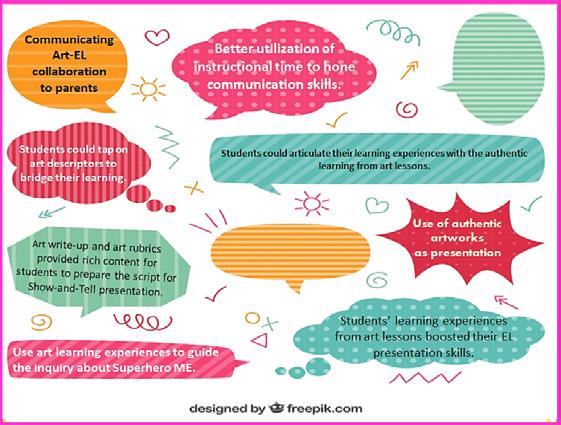
Reflection of teachers on Art-EL Collaboration
An Interdisciplinary Collaboration between Art & Literature
Written by Ms Farhana Wahianuar, Art Teacher from Tanjong Katong Girls’ School
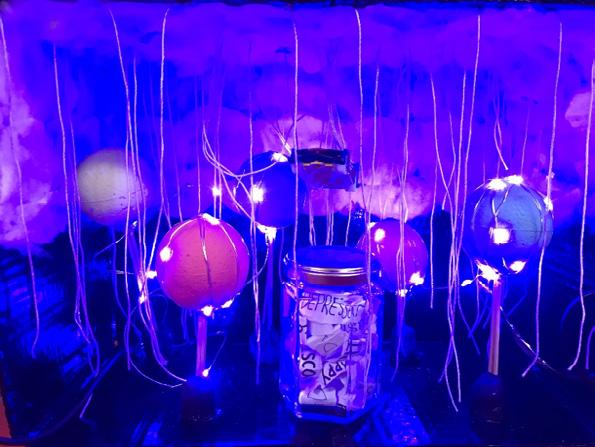
Throughout Semester 1, the Secondary 1 Art and Literature teachers of Tanjong Katong Girls’ School worked together to enhance the delivery of their respective syllabus.
This interdisciplinary collaboration was based on the following question, ‘What shapes one’s identity?’ Secondary 1 Art and Literature students studied, analysed and formed a critical understanding of the artworks of Joseph Cornell & Lucas Samaras. At the same time, their focus for Literature was their text, ‘Red Sky in the Morning’. This naturally compelled them to form an understanding and get into conversation about the interaction of Art and Literature. It was hoped that this exercise could enhance their understanding of the disciplinary languages of both subjects.
Using the Art Inquiry Model as a guide, students reflected on this question through several Inquiry Stages such as Connect & Wonder (through their reflections, study of artists artworks, art discussion with their table partners/group members), Express (through their drawings & reflections) and Investigate (through their artmaking process & choice of art materials).
What sparked the collaboration between Art & Literature?
In previous years, students were required to create identity boxes for Art and separately, diorama boxes for the characters in the Literature text. The Art and Literature teachers toyed with the idea, ‘transfer of learning’. The teachers came to a consensus that this was a useful skill for students to master and apply to different disciplines and subjects.
Objectives of the lessons: Infusing 21st Century Skills in Art Lessons
The objective of my lesson was for students to understand how art can tell stories about our
world. Through exploration of the works of Lucas Samaras and Joseph Cornell and their use of ‘symbolic representation’, it was hoped that students would be able to communicate the deeper meaning of ‘identity’ beyond one’s physical appearance. Through the use of ‘symbolic representation’, students then investigate the characters in their Literature text with the aim that they will be able to put themselves in the characters’ shoes.
How was the planning done?
As this was a first of its kind collaboration involving the Secondary 1 Art and Literature teachers, a lot of planning was involved. As an Art teacher, I was cognizant of the immense difference between teaching solely Art and undertaking a project of this scale. Teaching Art alone, there is always a window for me to be flexible in my teaching and to tweak parts of the lesson taking into consideration the capability and pace of my students. However, during this project, we had to ensure that teachers across both departments were working in tandem. It was pertinent that content had been covered and that students were equipped with prior knowledge to maximise their learning.
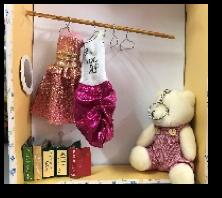

For instance, during Art lessons we would ask students to share the traits of each character in the Literature text and create a visual mindmap. Similarly, during Literature lessons, the Literature teachers would ask students to share their understanding of the theme: identity, and give examples from their artist reference, which was something they learnt during Art lessons.
To augment benefit from this project, the Art and Literature teachers shared resources from our respective content areas. Several meetings, both formal and informal, took place before the start of term to plan our objectives, activities and mode of assessment. We contemplated ways each subject could support the other. For instance, while the making of the identity boxes was done during Art Lessons, the task of awarding marks was a concerted effort of both departments. This involved robust discussions and many questions were raised during our marking sessions. It was an enjoyable and interesting experience for the teachers as well. In addition, we also discussed important thinking processes (not just the final works) that took place for example, in their drawings, visual


Examples of Identity Boxes.

Investigate factors that shape one’s identity: example of students’ Visual Mindmap on their identity and worksheet to guide students’ responses on their personal objects.

Connect & Wonder about themes: examples of personal objects, such as dolls and colour pencils gifted by family members.

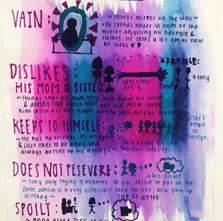
Express through discussions and feedback: a study of ‘Mrs Peacock’s’ trait and an example of a group’s drawing of ‘Mrs Maynard’s’ Identity Box.




Responses from Teachers:
Make identity boxes using found objects, symbols and/or imagery that represent key elements of the characters’ identity: example of Group Visual Mindmap based on one of the characters in Red Sky in the Morning and an example of a completed Identity Box for ‘Tony’.

"Interdisciplinary learning encourages students to think beyond the textbook and allows them to see how content from one subject can be applied to the other."
-
Ms Rachel Kwan (Literature Teacher)
"Students had fun coconstructing their diorama boxes while exploring and negotiating the many possibilities and ideas with their peers. Most importantly, it enabled students to see how learning comes alive."
- Ms Cheryl Chua
(Art Teacher)
mindmaps or discussion. The Literature teachers were also able to understand the knowledge and skills the students picked up from their Art lessons and this would allow them to tap on these skills during future lessons, increasing students’ engagement in interdisciplinary learning.
Thoughts/Reflection:
Revisit Existing Lessons & Applying it to Lessons in other Levels
Experimenting with new themes or even creating a new set of lessons can seem a daunting task. Developing a set of objectives, lesson materials, and assessment rubrics involves careful consideration and attention to detail.

As daunting as it may seem, it is actually not necessary to revamp a whole unit or lesson plan/ideas each time. The approach I took was to review the existing lessons that I have carried out with my previous batch of Secondary 1 students. I was able to make comparisons with previous lessons to understand what worked and what did not. This also made me more aware of the challenges that I needed to overcome. This allowed me to reflect, fine-tune and where necessary, perform a complete overhaul on aspects of a lesson.
In this instance, I was more conscious of infusing the Inquiry aspect into my lessons. The Art Inquiry Model, apart from providing a clear and organised structure to plan my lessons, also steered students towards becoming flexible thinkers through embracing uncertainties and to apply knowledge gained from one subject to another.
With this, I am hopeful that I can fine tune my lessons further in a continued effort to equip my students with 21st century skills.

Junior School.
Primary Art Teachers Learn and Bond through Sharing -- An Interview with Amy Koh and Faridah Hajarmustika
Written by Ms Low Sok Hui (Senior Academy Officer, Art) and Ms Leong Man Wei (Studio Assistant)
from STAR
"We realised that different schools have different ways to solve common issues. So when we get together and talk about them as a group, we get to listen and try out varied and different ideas to the challenges we face as art teachers."
We thoroughly enjoyed our interview with two of our engaging and affable primary Art teachers – Ms Amy Koh (Senior Teacher) from Montfort Junior School and Ms Faridah Hajarmustika (Subject Head, Aesthetics) from Maris Stella High School (Primary). Amy and Faridah are CoChairpersons of the N4 Aesthetics Support Group - Primary Art Community of Practise (CoP), whilst Mr Edwin Ong, VP, Maris Stella High School (Primary) oversees the Aesthetics support group for both primary and secondary schools in N4. Their sharing is a great story about teacher-agency and teacher-led culture in our art education landscape.
Could you share some background information about the N4 Primary Art CoP?
Amy: The CoP was initiated by the N4 Cluster Superintendent some years back. At that time, it was inclusive of Art and Music teachers from both primary and secondary schools in the cluster. However, we felt that for more fruitful sessions and effective support, it would be better for the Art teachers from the primary schools to focus and meet as a group. So, last year, the seven of us from the primary schools re-grouped and came together to form the N4 Primary Art Aesthetics Support Group. We have funding which provides for refreshments and materials for art jamming. Although it is only a small amount, it is a goodwill gesture from the cluster to recognize the importance of our PD. Furthermore, our CoP is recognized by our respective schools.
Faridah: It was interesting when we started with Art and Music and with secondary schools. But when we streamlined our meetings for just primary school Art teachers last year, I found it more beneficial, focused and relevant for the group.
Who is involved in the N4 Primary Art CoP?
Amy: There are seven of us -- 1 Head of Department, 1 Subject Head, 3 Senior Teachers, and 2 Art coordinators. So we have different skills and experiences that can be shared. Faridah handles the paperwork as well as the budget. She also takes charge of submitting a report at the end of the year.
Faridah(left) and Amy (right) in front of a student-painted mural at Montfort
What is the duration of each CoP session?
Faridah: Every first Thursday of the month is reserved for our meetings. Each session is about 2 hours (from 2 to 4pm) but teachers could stay longer. Usually when we are engaged with the learning, we’ll stay longer.
Amy: We meet at the different schools so all of us get to visit and see how the schools are set up differently. We also take turns to do our sharing sessions so everyone has a chance to share.
What do you like about this CoP?
Amy: When we mooted the idea of having the primary Art teachers come together as a support group, we did it out of our own free will. Attendance has been good so far; teachers will turn up unless they have other workrelated commitments. We enjoyed each other’s company and we appreciated the sharing amongst our colleagues. At times, it can be quite lonely for us as Art teachers in school as there would only be one or two of us around. So it has been great to have a support group like this where we get to meet like-minded Art teachers whom we could ask for help when the need arises. Or, if we organise certain schools events, we could ask for support or invite the rest to participate. For example, in Montfort we organised an event, PAM (PE, Art & Music) Night last year and I invited our cluster teachers to come to experience it and also shared with them how it can be done.
During the last support meeting, we met at North Spring Primary which has just set up an art gallery and organized an overseas art trip to Vietnam. A number of us have never done things like these before, so we were interested to find out how Belle Taw (HOD) did it – what were the funds she tapped upon, how to structure the overseas programme, who to approach, etc. There were so many things that we could learn from another colleague’s experiences. We always have a fruitful and enjoyable time together. I enjoy the support and sharing from our CoP’s members and it’s a gathering that makes a lot of sense.
Faridah: Our CoP group meets on our own accord and it is not mandated. And the teachers have been active and we are very happy to have this platform. I think the fact that you know that you are not alone in the fraternity doing certain things makes us more grounded too.
How do you sustain interest and motivation for teachers in this CoP?
Amy: There must also be a clear purpose and shared ownership of the meeting. The sessions are truly beneficial for everyone in the group. We take turns to share and would incorporate a small art jamming session into the session too if possible. This year an additional motivation was that we got to visit each other’s school. It’s always exciting to go to a new venue. We love to see how other schools install their children’s work and decorate their school. For our CoP, we
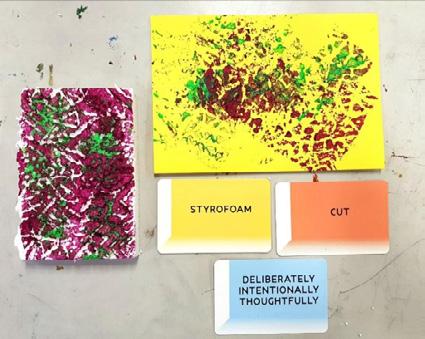

are motivated to meet up and the support for teachers to leave school to attend the meetings is there.
Faridah: We have a close rapport with our teachers. We have a group chat and we periodically check on each other.
Amy: It’s easier to establish the rapport when we all have the same love for the subject. The art jamming sessions are enjoyable. So far we tried the Making Art kit and 3D Pen Art. We have so much to talk aboutclassroom teaching issues, deployment, pedagogy, etc. We realised that different schools have different ways to solve common issues. So when we get together and talk about them as a group, we get to listen and try out varied ideas to the challenges we face as Art teachers.
In what ways does the CoP encourage teacher agency and a collaborative culture among teachers?
Amy: Over these few years, STAR has cascaded IBL strategies to the STAR Champions selected from different clusters and after the STAR Champs had learnt new strategies, they would do a cascading zonal workshop for the teachers in their cluster and zone. After that workshop, we would not have much time to meet up with the cluster Art teachers again. So, if every cluster can have a support group like this CoP, the learning and support can cascade down further. The cluster group can meet and they can further support each other.
Faridah at the 2017 PAL Conference
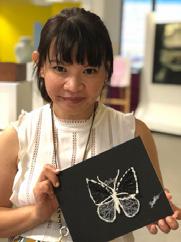
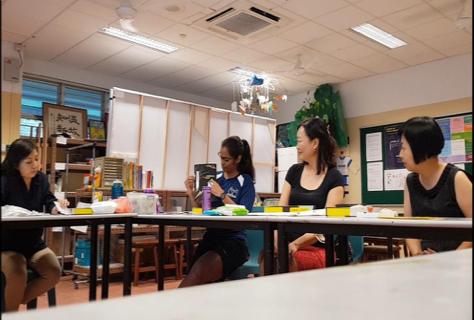
Faridah: Besides sharing, we also do art jamming during our CoP sessions. Last year, Amy and I facilitated an artmaking session using STAR’s Making Art kit with the group. So we learnt how to use the kit to create our own artwork and in the process learnt how to use it for our lessons as well. Sometimes, when STAR rolls out certain resources, they might not have sufficient platforms to share with teachers on how the resources can be used. So when we have such peer sharing sessions, we reach out to an even wider audience.
Amy: In the previous session at North Spring, I shared on the use of 3D pen. My school, Montfort Junior, is into the Maker’s culture. We use the 3D pen in our curriculum and the students are very engaged. The cluster teachers had never tried this medium before so we had a small art jamming session on that and I shared how I incorporated it into my art programme. Teachers also had a hands-on experience with the pen to create their artwork.
Last year when Faridah presented at the 2017 PAL Conference, we all went to support her. This year I will be presenting at Rosyth’s Aesthetics Learning Festival and they will come too. So we provide support for one another and learn at the same time. When we go through the same PD, we have something common to reflect and discuss about in our follow up sessions.
Recently, we’ve been sharing about museumbased learning as well as STP. Another good thing about this platform is that when we attend different meetings or workshops, we can share the learning when we come together. It’s good that we share on different things; sometimes there are so many workshops organised by STAR and we are unable to attend all of them. By coming together, we are tapping on the collective learning experiences of everyone in the group. Like now, Tiang Wen and I are attending the Drawing NLC, so we could probably share with the group what we’ve gained and learnt.
Faridah: We get to network with other teachers. We leverage on other people’s knowledge and we get feedback and hear comments from one another. We share some of the current classroom issues we are facing, get contacts and feedback on instructors and vendors, learn how to plan and carry out certain event. We do have lots to learn from each other.
We also keep the group open. We invite our teachers to come, not just the Heads and the STs. They can participate in any of the CoP activities. In fact even teachers from other clusters who are interested to join a support group are most welcome to contact us and join us.
"We are passionate Art teachers.
Passionate about Art!"
Going forward, what plans do you have for the CoP?
Amy: We do have requests from teachers who have heard about our CoP and asked if they could join us. It’s not a bad idea if we can open it up to teachers outside our cluster. If they do not have a platform like ours and would like to join us, why not, right? Because, at the end of the day, it’ll be beneficial to all.
Faridah: Usually when Art teachers meet, it is because there is a workshop at STAR or because there is a STAR Champions meeting. It’s very rare that we as Art teachers meet to really get to know each other and talk about issues pertaining to our craft. So we definitely welcome other teachers to join us. They might not be able to attend every session but they could come for the ones that interest them.
Amy: We want to learn more, share more and be advocates of Arts, especially now that STAR is going out in full force to improve the art programmes and the quality of Art teachers in Singapore. The force is there and we are riding on the wave.
Reflecting on yourself as an Art teacher, what do you enjoy most about your job?
Amy: That the pupils are always excited to see me. We are the popular teachers. My students would clap when I pick them up from their class. I have children who would run to me and question me if I had been away from school and they missed their Art lesson as a result. It’s so heart-warming to know that I’m missed and they are my motivation to go to school every day.
Faridah: But herein lies the challenge as well -- of creating that rapport with our students as we only see them once a week. So it’s great when we know that students are happy to see us. Sometimes they are so excited to see me that I have to contain their excitement in order to have an ideal lesson. So for us, we must constantly reflect upon what good came out of each lesson. What did my students learn? Not every lesson is perfect because we have different classes, different paces and different challenges.
Finally, what will be the one word that you’ll use to describe your N4 cluster?
Faridah: Chill, calm people? Complement? Support?
Amy: One word…
Faridah: Support?
Amy: Passionate!
Faridah: I was just thinking that when we end the meeting, we would really miss the time together.
Amy: Yes, I was just telling my HOD that when we had our first meeting this year, the teachers initially asked what time the session would end. I told them 4pm and tried very hard to keep to the time. But on that day, at 4.30 pm, they were still asking questions and chatting! So it must have been a good session for them. They must have enjoyed themselves.
Faridah: So, what’s the one word?
Amy: We are passionate Art teachers. Passionate about Art!
3D Pen Art Jamming (Belle Taw)
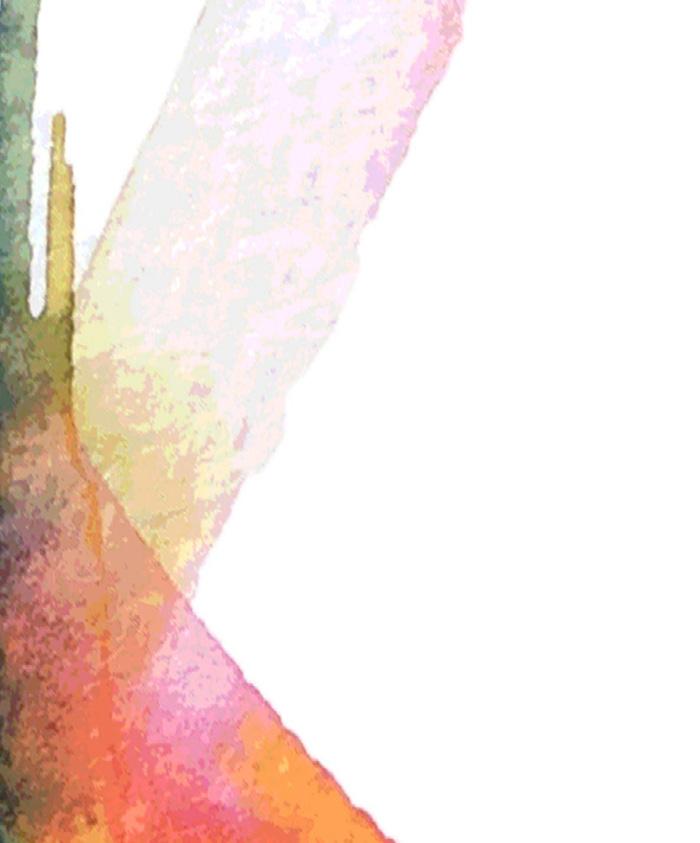
ARTS FOR THE FUTURE: Intersections and Transformation Arts Education Conference 2018
Thursday, 8 November 2018
Save the date! Arts Education Conference (AEC) 2018, co-organised by STAR and AEB, invites1 Art, Music, Drama and Dance teachers to join us on this one-day learning experience and professional exchange. The conference theme Arts for the Future: Intersections and Transformation will open a space for us to examine creativity in the Arts and the potential of the Arts to facilitate engagement, innovation, and optimism for the future.
AEC 2018 will include keynote addresses, subject spotlights, panel discussion, masterclasses and concurrent sessions by international and local thought leaders, researchers, artists and educators. We will also showcase pedagogical innovations by Art STAR Champions and Art Networked Learning Communities participants as well as artistic experimentation by teacherartists in various studio-based supporting programmes.
The learning sessions and showcase will be curated based on 3 strands that expand on the conference theme of intersections and transformation.
Strand 1
Intersections in Disciplines
Arts educators are lifelong learners who take advantage of new knowledge to design rich learning experiences for our students. We seek intersectional ideas and forward-looking perspectives by exploring connections with other disciplines and leveraging on technologybased innovations. Our ability to imagine a myriad of possibilities and find uncharted connections could inspire new ways of knowing and teaching the Arts. In turn, our students are encouraged to develop dispositions that value multiple perspectives, and a spirit of exploration and innovation in a digital world.
1
Strand 2
Networks and Partnerships
Arts educators are situated in an ecology of networks and participatory cultures, which provide stimulating environments for a growth mindset. Through professional exchange, collaborations, and partnerships, the Arts fraternity becomes a collective of professional capital built over time to enrich teaching and learning. Creative capacities are further strengthened with the purposeful participation of local arts communities and creative industries. Such networks and cultures facilitate generative processes, and create powerful and sustainable means for deeper conversations to impact and influence the teaching of the Arts in our classrooms.
Strand 3
Arts as Catalyst for Change
A critical dimension of professionalism, teacher agency actively shapes how Arts educators champion Arts teaching to play a significant contribution in nurturing the whole child, and how Arts educators impact and influence communities. We believe in the power of the Arts to move beyond the aesthetics into work that enables individuals and communities to effect change, whether in attitude or in action. In light of social and cultural globalisation, Arts education anchors values, nurture our students’ voices, and imbue in students a sense of identity and rootedness.
We look forward to hosting you and learning with you.

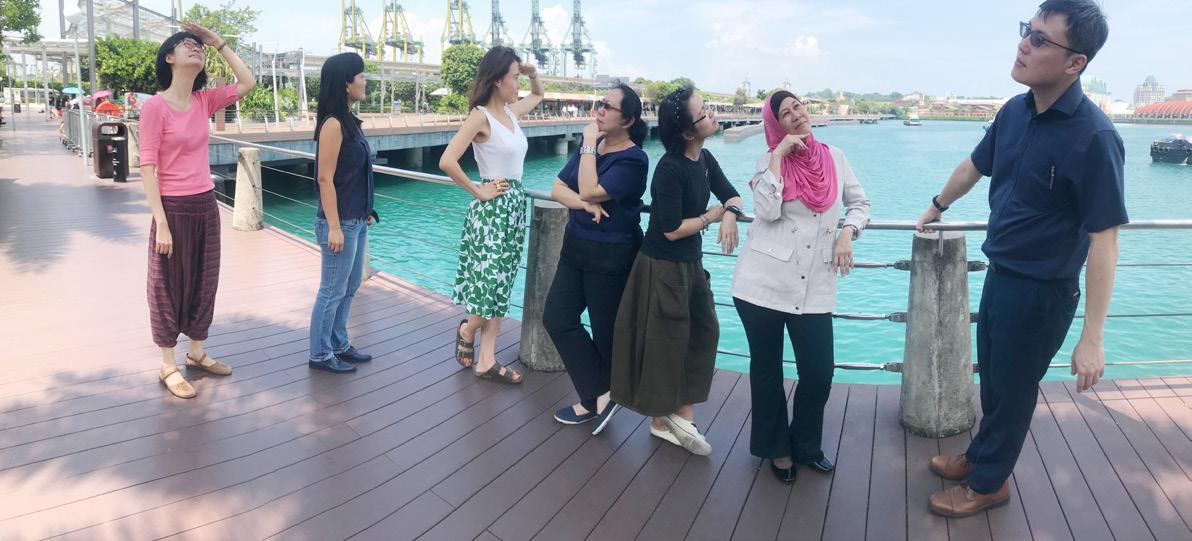
Ms Seow Ai Wee
Deputy Director (Art)
Mr Lim Kok Boon
Master Teacher (Art)
Seow_Ai_Wee@moe.gov.sg
6664 1558
Lim_Kok_Boon@moe.gov.sg
6664 1502
Mdm Victoria Loy
Master Teacher (Art)
Victoria_Loy@moe.gov.sg
6664 1551
Mdm Fatimah Sawifi Senior Academy Officer (Art)
Ms Dorathy Lye Senior Academy Officer (Art)
Ms Low Sok Hui Senior Academy Officer (Art)
Mdm Pang Ming Ing Academy Officer (Art)
Ms Tan Bee Nogh Programme Executive
Fatimah_Sawifi@moe.gov.sg 6664 1547
Dorathy_Lye@moe.gov.sg 6664 1546
Low_Sok_Hui@moe.gov.sg 6664 1548
Pang_Ming_Ing@moe.gov.sg 6664 1550
Tan_Bee_Ngoh@moe.gov.sg 6664 1549

